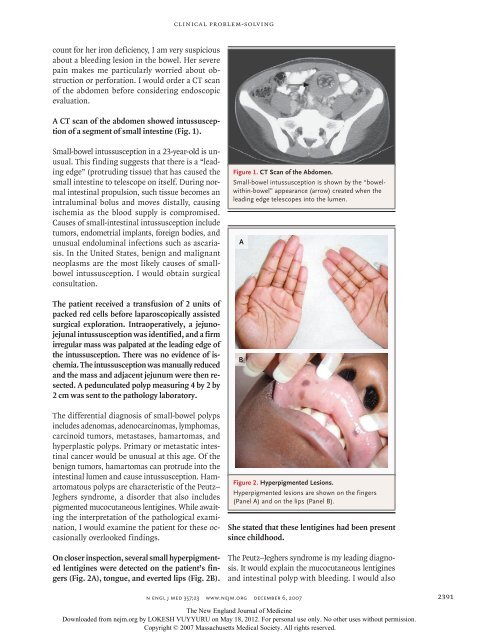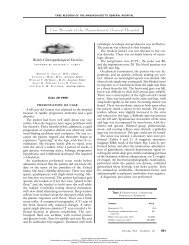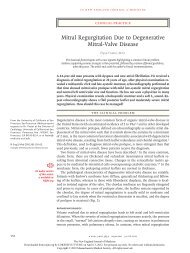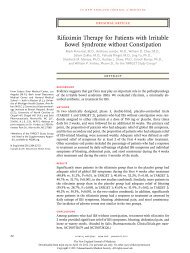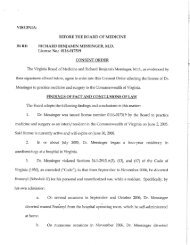The Leading Diagnosis
The Leading Diagnosis
The Leading Diagnosis
Create successful ePaper yourself
Turn your PDF publications into a flip-book with our unique Google optimized e-Paper software.
count for her iron deficiency, I am very suspicious<br />
about a bleeding lesion in the bowel. Her severe<br />
pain makes me particularly worried about obstruction<br />
or perforation. I would order a CT scan<br />
of the abdomen before considering endoscopic<br />
evaluation.<br />
A CT scan of the abdomen showed intussusception<br />
of a segment of small intestine (Fig. 1).<br />
Small-bowel intussusception in a 23-year-old is unusual.<br />
This finding suggests that there is a “leading<br />
edge” (protruding tissue) that has caused the<br />
small intestine to telescope on itself. During normal<br />
intestinal propulsion, such tissue becomes an<br />
intraluminal bolus and moves distally, causing<br />
ischemia as the blood supply is compromised.<br />
Causes of small-intestinal intussusception include<br />
tumors, endometrial implants, foreign bodies, and<br />
unusual endoluminal infections such as ascariasis.<br />
In the United States, benign and malignant<br />
neoplasms are the most likely causes of smallbowel<br />
intussusception. I would obtain surgical<br />
consultation.<br />
<strong>The</strong> patient received a transfusion of 2 units of<br />
packed red cells before laparoscopically assisted<br />
surgical exploration. Intraoperatively, a jejunojejunal<br />
intussusception was identified, and a firm<br />
irregular mass was palpated at the leading edge of<br />
the intussusception. <strong>The</strong>re was no evidence of ischemia.<br />
<strong>The</strong> intussusception was manually reduced<br />
and the mass and adjacent jejunum were then resected.<br />
A pedunculated polyp measuring 4 by 2 by<br />
2 cm was sent to the pathology laboratory.<br />
<strong>The</strong> differential diagnosis of small-bowel polyps<br />
includes adenomas, adenocarcinomas, lymphomas,<br />
carcinoid tumors, metastases, hamartomas, and<br />
hyperplastic polyps. Primary or metastatic intestinal<br />
cancer would be unusual at this age. Of the<br />
benign tumors, hamartomas can protrude into the<br />
intestinal lumen and cause intussusception. Hamartomatous<br />
polyps are characteristic of the Peutz–<br />
Jeghers syndrome, a disorder that also includes<br />
pigmented mucocutaneous lentigines. While awaiting<br />
the interpretation of the pathological examination,<br />
I would examine the patient for these occasionally<br />
overlooked findings.<br />
On closer inspection, several small hyperpigmented<br />
lentigines were detected on the patient’s fingers<br />
(Fig. 2A), tongue, and everted lips (Fig. 2B).<br />
clinical problem-solving<br />
Figure 1. CT Scan of the Abdomen.<br />
Small-bowel intussusception is shown by the “bowelwithin-bowel”<br />
appearance (arrow) created when the<br />
leading edge telescopes into the lumen.<br />
ICM AUTHOR Baudendistel<br />
RETAKE 1st<br />
REG F FIGURE 1 of 3<br />
2nd<br />
CASE<br />
3rd<br />
TITLE<br />
Revised<br />
EMail Line 4-C<br />
Enon ARTIST: mst<br />
SIZE<br />
A<br />
H/T H/T<br />
FILL<br />
Combo<br />
16p6<br />
AUTHOR, PLEASE NOTE:<br />
Figure has been redrawn and type has been reset.<br />
Please check carefully.<br />
B<br />
JOB: 35723<br />
ISSUE:<br />
12-6-07<br />
Figure 2. Hyperpigmented Lesions.<br />
Hyperpigmented lesions are shown on the fingers<br />
(Panel A) and on the lips (Panel B).<br />
ICM AUTHOR Baudendistel<br />
RETAKE 1st<br />
REG F<br />
CASE<br />
FIGURE 2a&b of 3<br />
TITLE<br />
2nd<br />
3rd<br />
Enon ARTIST: mst H/T<br />
4-C<br />
H/T<br />
FILL<br />
Combo<br />
16p6<br />
She stated that these lentigines had been Revised<br />
EMail present<br />
Line<br />
since childhood.<br />
SIZE<br />
<strong>The</strong> Peutz–Jeghers AUTHOR, syndrome PLEASE is NOTE: my leading diagno-<br />
Figure has been redrawn and type has been reset.<br />
sis. It would explain Please the check mucocutaneous carefully. lentigines<br />
and intestinal polyp with bleeding. I would also<br />
JOB: 35723<br />
ISSUE:<br />
12-6-07<br />
n engl j med 357;23 www.nejm.org december 6, 2007 2391<br />
<strong>The</strong> New England Journal of Medicine<br />
Downloaded from nejm.org by LOKESH VUYYURU on May 18, 2012. For personal use only. No other uses without permission.<br />
Copyright © 2007 Massachusetts Medical Society. All rights reserved.


